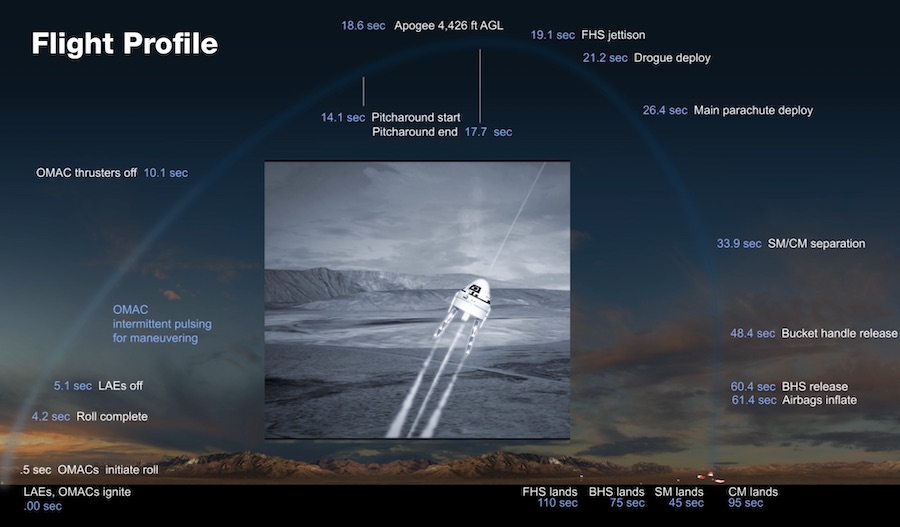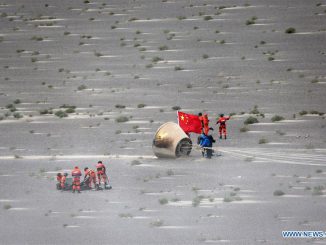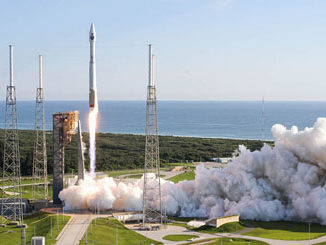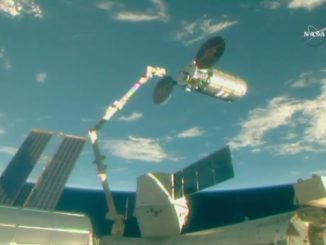Boeing and SpaceX are readying for launch abort tests in the coming weeks to validate the crew escape systems for the new human-rated Starliner and Crew Dragon spaceships, now scheduled to begin ferrying astronauts to the International Space Station in the first half of next year.
The abort tests are scheduled to begin as soon as next week, when Boeing plans a pad abort test of a test version of its Starliner crew capsule Monday, Nov. 4, in New Mexico. SpaceX is gearing up for a ground test-firing of the Crew Dragon’s abort engines at Cape Canaveral as soon as Wednesday, Nov. 6.
“It’s a very complicated dance as we’re getting ready to go fly,” said Kathy Lueders, who manages the commercial crew program at NASA. “We’re heading into a period of final, big integrated tests … along with tons of certification work. We tend to not say it’s just paper, because it’s not just paper, it’s all the key things that are showing that the design is qualified and we have the vehicles at the right risk level for us to be able to fly on them.”
NASA tasked Boeing and SpaceX to develop new human-rated spaceships to end U.S. reliance on Russian Soyuz spacecraft to carry astronauts to and from the International Space Station. Once they complete crewed test flights, the Starliner and Crew Dragon spacecraft will begin regular crew rotation missions to the orbiting research laboratory.
The space agency awarded commercial crew contracts to Boeing and SpaceX in 2014 valued at $4.2 billion and $2.6 billion, respectively.
After years of delays attributed to a lack of funding and technical problems, Boeing and SpaceX officials say their spaceships should be ready to carry astronauts into orbit next year. Bob Cabana, director of NASA’s Kennedy Space Center, said this week he expects the capsules to be ready for crewed flights in six to eight months.
The three-hour window for Boeing’s pad abort test opens at 7 a.m. MST (9 a.m. EST; 1400 GMT). A full-scale test model of Boeing’s Starliner spacecraft — with a crew module and service module — will take off from a launch pad at the U.S. Army’s White Sands Missile Range in New Mexico on fast-paced test of the capsule’s emergency escape system.
NASA TV will broadcast the pad abort test live.
“I call this an ejection seat for a spacecraft,” said Chris Ferguson, a Boeing test pilot, astronaut and director of Starliner crew and mission systems.
The pad abort test will demonstrate the Starliner can “rapidly separate itself and gain distance from the launch vehicle should something go wrong,” Ferguson said Oct. 22 in a panel discussion at the International Astronautical Congress in Washington.
Ferguson will fly on the Starliner’s first crewed mission, a test flight that is expected to launch next year.
During a crewed launch, emergency escape engines on the base of the Starliner’s service module would propel the spacecraft off the top of its United Launch Alliance Atlas 5 rocket in the event of a failure on the launch pad at Cape Canaveral. The pad abort test set for Monday morning will prove the Starliner’s escape system is up to the challenge.
“We’ll go from zero speed, zero altitude, and safely demonstrate about a 1-mile-high, about a 1-mile downrange capability to remove the vehicle and safely bring it down in what will be a desert environment for the White Sands test, but what would be just off the coast of Florida if we, in fact, did have a launch pad abort.
“A lot of everything that we’ve been working on for the last eight years or so (is) all wrapped up in about a 90-second test, so it’ll be pretty exciting,” Ferguson said.
No astronauts will fly on the capsule during the pad abort test.

On a space mission, Boeing’s Starliner will have 64 engines for use during launch aborts, in-orbit maneuvers and re-entry. All of the thrusters are built by Aerojet Rocketdyne.
The four biggest thrusters are the launch abort engines on the base of the Starliner’s service module. In the event of an abort, each engine would immediately ignite and power up to produce some 40,000 pounds of thrust to push the spacecraft away from rocket failure on the ground or in fight.
The liquid-fueled abort engines, burning a noxious mixture of hydrazine and nitrogen tetroxide, would only fire in flight in the event of a launch emergency.
Another set of 20 service module orbital maneuvering and attitude control engines, each generating 1,500 pounds of thrust, will be used to control the capsule’s orientation during a launch abort, orbital insertion after separation from the Atlas 5 rocket’s second stage, and other major trajectory changes in space.
There are 28 reaction control system thrusters on the Starliner service module for smaller orbital maneuvers, and for reboosts of the space station’s orbit. Twelve reusable thrusters on the Starliner crew module, each with 100 pounds of thrust, will control the ship’s attitude, or orientation, during re-entry.
The Starliner capsule slated for next week’s pad abort test is mounted on top of the same type of adapter that will connect the real spacecraft to the top of ULA’s Atlas 5 rocket. When the craft ignites its four launch abort engines, vent doors on the adapter will open to prevent an over-pressure event.
For the pad abort test, the four launch abort engines, or LAEs, will ignite for 5.1 seconds, producing a combined 160,000 pounds of thrust to propel the spacecraft off a test stand at White Sands. The smaller orbital maneuvering and attitude control, or OMAC, thrusters will fire for 10.1 seconds to initiate a roll maneuver and govern the capsule’s orientation.
Then thrusters will pulse to flip the spacecraft around and fly tail first on an arc that will take the vehicle to a maximum altitude of approximately 4,426 feet (1,349 meters) above ground level around 18.6 seconds after takeoff.
The thrusters will stop firing 17 seconds after takeoff, and a series of pilot, drogue and main parachutes will begin deploying at T+plus 20 seconds, according to Boeing.
The craft will jettison its service module at T+plus 34 seconds to fall to the ground. The crew module will then release its base heat shield, then inflate airbags to cushion the capsule’s landing at White Sands around 95 seconds after liftoff.
SpaceX completed the pad abort test for its Crew Dragon spacecraft in 2015, and plans an in-flight abort test later this year at the Kennedy Space Center to verity the capsule’s ability to fire off a Falcon 9 rocket after liftoff. Boeing plans to bypass such an in-flight abort demonstration.
NASA gave both companies the option to decide whether or not to conduct an in-flight abort test.
Lueders called the Boeing pad abort “a huge test for us.”
“Obviously, it’s going to be important for us to understand how the separation works for the CM and SM (crew module and service module), checking out the chutes, making sure that the predictions are lined up right for us,” Lueders said Wednesday during a presentation to the NASA Advisory Council’s human exploration and operations committee.
Boeing is in the final stages of assembling and testing two space-ready Starliner vehicles inside a former space shuttle hangar at NASA’s Kennedy Space Center in Florida.
The first of the capsules is scheduled to launch as soon as Dec. 17 aboard an Atlas 5 rocket from pad 41 at Cape Canaveral Air Force Station for a week-long unpiloted test flight to the space station. That mission, called the Orbital Test Flight, will not have an active abort system, but Lueders said NASA wants to see how the Starliner performs on the abort test before going ahead with the OFT mission.
“OFT does not have the abort system on it because it’s an uncrewed mission, but obviously the way the system separates and everything else will reflect on our OFT progress, so it’s critical for us to get this test going and that we understand it prior to us doing rollout of the spacecraft (for OFT),” Lueders said Wednesday.
The Starliner’s Crew Flight Test to the space station will follow some time in the first half of 2020, with Ferguson joined by NASA astronauts Mike Fincke and Nicole Mann.
Meanwhile, SpaceX engineers at Cape Canaveral are on track for a critical test-firing of the SuperDraco abort thrusters on the company’s Crew Dragon spacecraft.
Test of Crew Dragon’s upgraded launch escape system ahead of static fire and in-flight abort tests – altogether we are conducting hundreds of tests to verify the system’s advanced capabilities to carry astronauts to safety in the unlikely event of an emergency pic.twitter.com/a4FucMh85l
— SpaceX (@SpaceX) October 24, 2019
The test-firing next week will be a repeat of a ground hotfire test SpaceX attempted in April, which ended in an explosion that destroyed the Crew Dragon spacecraft that successfully completed an unpiloted test flight to the space station the month before.
Investigators determined a leaky valve inside the Crew Dragon’s abort propulsion system led to the explosion. “Honestly, for us, for the year going into crewed flight, having something like that happen is a big wakeup call for the team, that they have to be diligent and careful about this,” Lueders said. “We lost the vehicle very quickly.
“That was a very dear vehicle for us,” she said. “We were on a high coming off Demo-1 (the unpiloted test flight), then to lose that vehicle. That vehicle was going in a museum somewhere. I’m really proud of the way the team over the summer has carefully worked through the anomaly investigation, worked through the changes in the system.
A faulty check valve inside the propulsion system allowed nitrogen tetroxide oxidizer, which the Crew Dragon’s eight SuperDraco rocket engines consume mixed with hydrazine fuel, to enter high-pressure helium tubes during ground processing before the attempted hotfire test in April.
The helium system is used to quickly pressurize the propulsion system, allowing the SuperDraco thrusters to fire up during a launch emergency. The eight SuperDraco thrusters cumulative generate 128,000 pounds of thrust, serving the same function as the launch abort engines on Boeing’s Starliner.
When the abort system began pressurizing on the April test, nitrogen tetroxide that had leaked into the helium pressurization system was driven back into the check valve, which is made of titanium.
“Imagine a lot of pressure driving back a slug of liquid (that) has significant force, and that basically destroyed the check valve and caused an explosion,” said Hans Koenigsmann, SpaceX’s vice president of build and flight reliability, in a July press briefing.
“We found out that … when the pressure is high, and you drive a slug with a lot of energy into a titanium component, that you can have this rather violent reaction,” Koenigsmann said.
The violent result was surprising. Engineers did not expect titanium, a material commonly used for decades on space vehicles around the world, could react so explosively in such an environment.
SpaceX added a burst disk to prevent propellant from leaking into the high-pressure lines before ignition.
On rockets and spacecraft, burst disks are designed for a single use. The burst disks block the pathway between the propellant and pressurization systems until they rupture during the engine startup sequence, allowing fluids to mix.
Assuming the SuperDraco hotfire test goes well, SpaceX will refurbish the capsule for an in-flight abort test scheduled as soon as early December, Lueders said Wednesday.
A full-scale Falcon 9 rocket — with all its parts other than a second stage engine — will loft the Crew Dragon capsule into the stratosphere for the high-altitude abort demonstration.
The in-flight abort test plan calls for the rocket to take off from launch pad 39A at the Kennedy Space Center and arc over the Atlantic Ocean, firing its nine main engines for nearly a minute-and-a-half, as it would during a typical launch. SpaceX will pre-program the Falcon 9’s nine Merlin booster engines to switch off after surpassing the speed of sound.
A computer on the Crew Dragon spacecraft will detect the loss of thrust and trigger an abort approximately 88 seconds after liftoff, Lueders said, and the capsule will parachute into the Atlantic, where recovery teams will be on standby to retrieve it.
Like Boeing, SpaceX is building a separate Crew Dragon spacecraft for the company’s first flight with astronauts, named Demo-2. NASA astronauts Bob Behnken and Doug Hurley are assigned to fly the Demo-2 mission to the space station.



